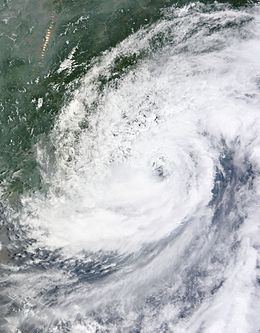Formed June 13, 2014 Fatalities 11 total | Dissipated June 23, 2014 | |
 | ||
Highest winds 10-minute sustained: 75 km/h (45 mph)1-minute sustained: 85 km/h (50 mph) Lowest pressure 996 hPa (mbar); 29.41 inHg Damage $131 million (2014 USD) Date 13 June 2014 – 23 June 2014 Similar Typhoon Krovanh, Typhoon Conson, Tropical Storm Kammuri, Typhoon Pabuk, Typhoon Wipha | ||
Tropical Storm Hagibis was a tropical storm that enhanced the southwest monsoon, bringing heavy rainfall to the Philippines for nearly a week in June 2014. The storm formed on June 13 and dissipated on June 18. Hagibis made landfall on June 15, causing damage estimated to be CNY 816 million ($131 million USD). Hagibis is a Filipino word, meaning fast or swiftness.
Contents
Meteorological history
On June 11, 2014, a broad, poorly-defined area of low pressure formed over the South China Sea. Extensive, though disorganized, deep convection accompanied the system. Situated within a region of low to moderate wind shear and weak outflow, slow development ensued. By June 13, the Japan Meteorological Agency (JMA) classified the disturbance as a tropical depression. A monsoonal system, the depression featured an extensive circulation with the strongest winds well away from the center, contrary to most tropical cyclones. A scatterometer pass revealed winds up to 65 km/h (40 mph) within a banding feature to the east of the storm's center by the evening on June 13. In accordance with this, the JMA upgraded the depression to Tropical Storm 1407 and assigned the name Hagibis to the cyclone. Despite the presence of gale-force winds, the Joint Typhoon Warning Center (JTWC) deemed the system to be below storm intensity and only issued a Tropical Cyclone Formation Alert early on June 14, indicating that it was likely to become a tropical cyclone within 24 hours. Thereafter, the aforementioned tropical storm-force winds contracted to within 130 km (80 mi) of the center, indicative of a more tropical than monsoonal system. As such, the JTWC initiated advisories on the system as Tropical Storm 07W.
Early on June 15, Hagibis made landfall over southern China as it further weakened to a tropical depression. On the morning of June 16, both agencies made their final warnings on Hagibis, as it weakened further to a land depression. Its remnants still continued to move northward, but by June 17, the remnants of Hagibis curved eastwards due to the jet stream. Later that day, it entered warm waters again and an area of low vertical wind shear, and the storm re-intensified as a result. JMA upgraded Hagibis back into a tropical storm, and both JTWC and JMA re-initiated advisories on Hagibis. Early on June 18, Hagibis transitioned into an extratropical cyclone, as its circulation was absorbed by a developing extratropical storm north of it on June 21. The system moved out of the basin early on June 23.
Philippines
Although Hagibis did not enter the PAR, it also threatened the Philippines by enhancing the southwest monsoon, bringing extreme rainfall to the country. Due to extreme rainfall since Tropical Storm Mitag on June 10, PAGASA declared the official start of the rainy season. It was reported that 17 towns in Maguindanao province were flooded. With that, a total of more than 90,000 people were affected.
Extreme rainfall continued to affect the country until June 27, when a tropical disturbance ended affecting northern Luzon.
China
Hagibis made landfall over southern China at 04:50 (UTC), June 15. About 13,000 people were affected by the storm. Economic losses from Hagibis reached a total of 577 million yuan ($93 million USD), but a total of between 814-16 million yuan ($131 million USD) had been reported as of June 20. No casualties were reported during the first week, but as of June 19, the Chinese Government had reported that 11 were dead in the affected regions from Hagibis.
Torrential rain continued to bring flooding until June 22, as the southwest monsoon weakened.
